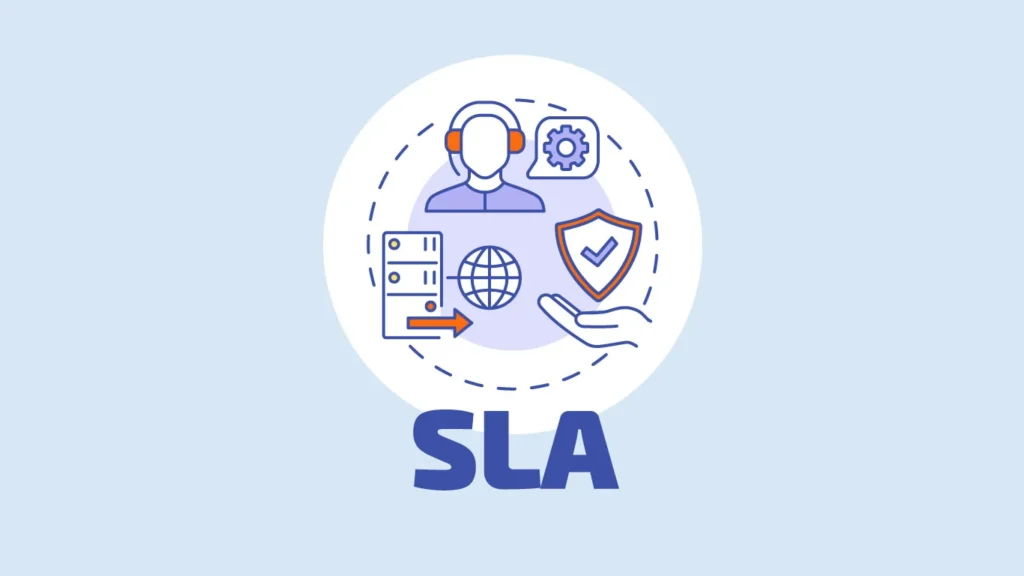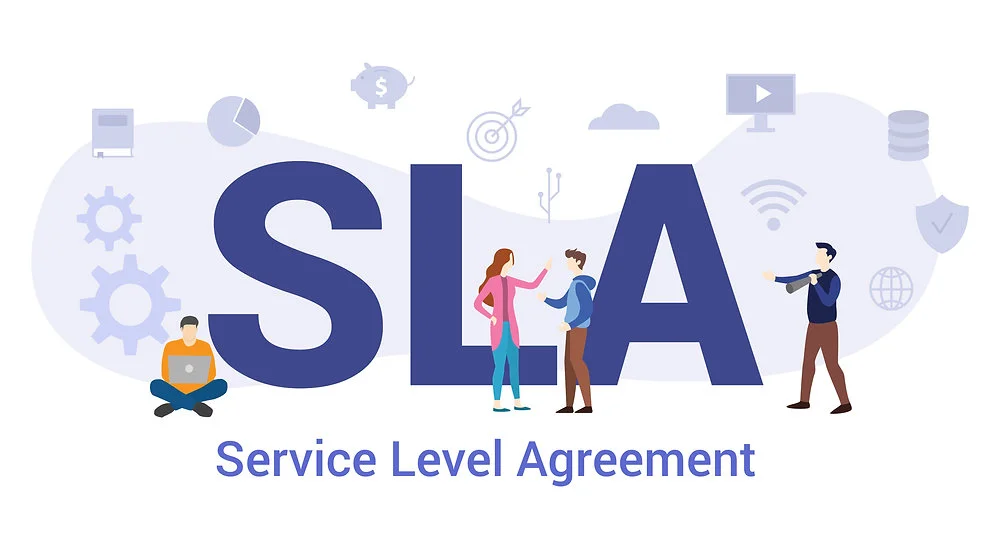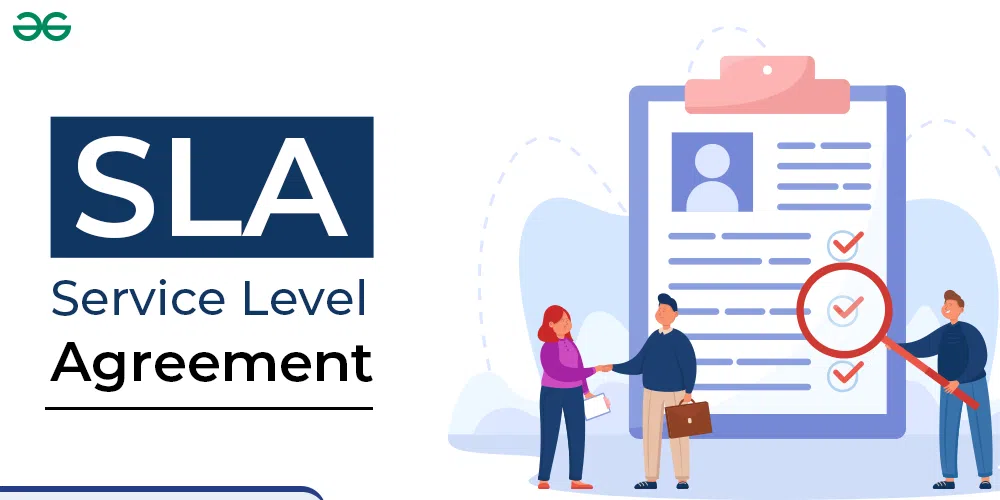Dealing with IT service contracts can feel like solving a puzzle without all the pieces. You might wonder why your provider isn’t meeting expectations or what to do if things go out of control. That’s where having a clear SLA (Service Level Agreement) becomes crucial. Without it, misunderstandings accumulate, leaving businesses frustrated. SLAs are more than just legal documentation. They outline how IT services will be provided and measured effectively. Think of it as a rulebook that ensures both you and your provider adhere to mutually agreed-upon standards. In this blog, we’ll explain SLA essentials in straightforward steps that safeguard your business interests. You’ll discover what to include in an SLA and learn ways to avoid common mistakes when collaborating with managed service providers. Ready to clearly understand SLAs? Keep reading!

What Is an SLA in Managed IT Contracts?
An SLA, or Service Level Agreement, defines the standards a managed IT provider must meet. It is a formal contract outlining service delivery expectations, performance metrics, and responsibilities between the provider and client. This document sets clear rules for areas like response times, uptime guarantees, and system support availability. An effective SLA turns vague promises into measurable commitments. It acts as a safeguard for clients while holding vendors accountable, especially when working with established providers that help businesses manage IT with clarity, like those who manage IT with XL.net. For example, if an IT system fails but isn’t fixed within the agreed timeframe, penalties may apply. This agreement helps build trust by ensuring both parties understand their roles in maintaining efficient operations.
In the next section we will go over some key components of a strong SLA in more detail.
Key Components of an SLA
A strong SLA sets the foundation for trust between businesses and IT providers. It clearly defines responsibilities, expectations, and consequences.
Scope of Services
Businesses must define the services a managed service provider will deliver. Specify tasks like IT support, network monitoring, and incident management. Include details about hardware maintenance, software updates, or data backups. This prevents misunderstandings between both parties. State what falls outside the agreed scope, too. For example, if development services aren’t included, mention it outright. Clarifying responsibilities helps avoid future disputes over unmet expectations. Transition to compliance metrics by examining how performance measurements tie into fulfilling these outlined services effectively.
Compliance Metrics
Compliance metrics track how well services adhere to agreed standards. Examples include uptime percentages, ticket resolution times, or data backup frequencies. These metrics ensure managed service providers fulfill their contractual obligations. Clear thresholds reduce uncertainty during performance reviews. For instance, an SLA might require 99.9% system availability per month and a four-hour response time for critical issues. “Accountability thrives on measurable standards.”.
Security and Data Protection
Protecting data requires stringent measures. Managed IT contracts must detail how providers will handle sensitive information. Encryption, secure backups, and access controls should be essential. Providers should describe precise protocols for preventing breaches or unauthorized access. Specify consequences for failing to meet security standards. Include details about audits and adherence to laws like GDPR or HIPAA if relevant. Address incident response plans to swiftly manage cyberattacks without disrupting operations. Clear expectations ensure your data remains secure and your business operates effectively.
Communication Protocols
Clear communication protocols keep managed IT contracts running smoothly. These rules outline how clients and providers exchange updates, raise issues, or share reports. For example, a service level agreement (SLA) might require weekly status meetings or written incident notifications within two hours of discovery. Without these detailed steps, misunderstandings can delay service delivery. Setting agreed-upon contact points reduces chaos during emergencies. Managed service providers often designate account managers or dedicated support teams to handle communication. Clients benefit from knowing exactly whom to call for technical assistance or resolution tracking. With well-defined methods in place, like ticketing systems or email alerts, issues are addressed faster, improving service reliability.
Contingencies and Remediation
Service failures occur, even with thorough planning. Businesses need to prepare for potential disruptions in managed IT contracts. Contingency plans should describe steps for addressing downtime, data breaches, or unmet SLA metrics quickly. These agreements often include escalation procedures and defined timelines to minimize extended service interruptions. Remediation clauses specify actions if providers fail to meet critical service expectations. Providers may propose refunds, credits, or additional services as compensation. This promotes fairness while ensuring accountability on both sides of the agreement. Clearly outlined remedies safeguard client interests and encourage dependable vendor performance without uncertainty.
After discussing the key aspects of SLAs, it is also important to understand why SLAs are essential for managed IT services.

Why Are SLAs Critical for Managed IT Services?
SLAs establish clear expectations between clients and providers. They serve as a safeguard when service delivery deviates.
Ensuring Service Accountability
Clear expectations ensure service delivery remains on track. Managed service providers closely monitor SLA metrics to meet agreed performance levels. Responsibility increases when specific timeframes, consequences for non-compliance, and incentives for meeting targets are included in the contractual agreement—principles widely adopted in managed IT frameworks, according to NCC Data. IT support teams address issues more efficiently with clearly outlined incident management processes. Frequent reporting maintains transparency between the client and provider. Service standards remain high when vendors adhere to measurable commitments and promptly resolve issues as they occur.
Defining Provider and Client Responsibilities
Managed IT contracts work best when both parties understand their roles. The service provider manages IT infrastructure, support, and performance. They should meet the agreed SLA measurements, like uptime or response time goals. Providers also protect sensitive data through proper security protocols and adherence to compliance standards. Clients must communicate their business needs. Sharing essential information helps providers adjust services to align with priorities. Clients are usually responsible for reporting issues promptly and providing necessary access to systems for troubleshooting or maintenance tasks. A strong partnership depends on each side fulfilling its responsibilities consistently without taking shortcuts or overlooking steps in the process.
Mitigating Risks with Clear Terms
Defining roles helps, but clear terms in the agreement protect both parties. Specific language reduces misunderstandings. Ambiguous clauses create loopholes and invite disputes. For example, stating “reasonable response times” leaves room for debate. Instead, specify exact timeframes like “respond within four hours.” Direct statements leave no room for confusion. Include conditions for service failures and resolution timelines. Terms should outline what happens if issues persist or performance falls below SLA standards. Add steps for escalating unresolved concerns to higher authorities or third-party mediators if needed. These measures minimize disruptions and prevent legal challenges later on.
Additionally, let’s go over the best practices for creating effective SLAs.
Best Practices for Creating Effective SLAs
Craft SLAs that align with your business communication style while ensuring everything is measurable and straightforward.

Tailoring SLAs to Business Needs
Customized SLAs directly address specific business priorities. A small startup may prioritize quick IT support for frequent issues, while a larger organization might focus on uptime guarantees for critical systems. Understanding these differences allows providers to set clear service-level objectives that align with what matters most. Including flexible terms ensures the SLA evolves with the company’s needs. For example, a growing firm might gradually require stronger cybersecurity measures or faster issue resolution times as its operations expand. This flexibility keeps contracts applicable and effective over time, leading to measurable standards next.
Defining Measurable Metrics
To create SLAs effectively, you need clear, measurable standards. Standards set the foundation for accountability between clients and managed service providers. They define in writing how vendors will meet service level expectations. Vague promises won’t suffice when businesses rely on consistent IT support. Quantifiable standards like response times, resolution times, uptime percentages, or ticket closure rates work best. For example, you might include a 99.9 percent network uptime commitment or resolve critical incidents within four hours. These standards must align with your business operations to track vendor performance without guesswork. Standards should focus on what matters most to your company’s workflow and goals. Avoid overwhelming contracts with excessive items that dilute priorities. Instead of endless specifics, prioritize key performance indicators tied directly to essential IT services such as infrastructure stability or incident management efficiency.
Regular SLA Reviews and Updates
Tying measurements to performance only works when they remain relevant. Regular SLA reviews ensure agreements stay aligned with business objectives and industry norms. Markets shift, technology advances, and client needs evolve. Obsolete terms can make service-level expectations ineffective or unfeasible. Plan periodic reviews at least once a year or after significant events like acquisitions or system upgrades. Involve both the managed service provider and client teams for clarity. Revise compliance measurements, escalation processes, or incident management protocols as necessary. Address any patterns in vendor performance measurements that stray from agreed thresholds before minor issues develop into major problems.
Including Termination and Change Policies
Termination clauses clearly define how either party can exit the contractual agreement. They cover circumstances such as repeated service failures or non-payment. Specifying notice periods, refund eligibility, and penalties helps prevent disputes during contract termination. Managed IT contracts often include conditions for early exits or automatic renewal terms to maintain clarity. Change policies describe procedures for modifying SLA metrics or extending services. These policies ensure both clients and managed service providers agree on adjustments before implementation. Including detailed steps reduces miscommunication when needs change due to business growth or IT infrastructure requirements.
Let’s not forget about the common mistakes that should be avoided.
Common SLA Mistakes to Avoid
Skipping over important details can lead to costly surprises later. Miscommunication during contract discussions often creates headaches for both sides.

Overlooking Performance Metrics
Ignoring performance metrics in an SLA can lead to major setbacks. Metrics like response time, uptime consistency, and ticket resolution rates show whether a managed service provider meets expectations. Without clear standards, providers might underperform while businesses remain unaware until damage occurs. It’s like driving without checking the speedometer; you risk losing control. Clear metrics act as safeguards for both parties. They keep IT support teams accountable and give clients assurance in service delivery. For example, specifying that critical issues must be addressed within one hour sets a clear expectation. Without such rules outlined, resolving problems could stretch unnecessarily long, disrupting daily operations or even revenue streams.
Failing to Address Remediation Terms
Neglecting performance metrics already creates faults in an SLA, but omitting remediation terms can jeopardize the entire agreement. Every managed service provider deal encounters issues—missed response times, downtime, or incomplete resolutions. Without clearly established remedies for service failures, both parties end up blaming each other when problems arise. Service contracts need well-defined clauses detailing what occurs after a breakdown. For example, businesses might require temporary backups during outages or credit refunds for extended disruptions. These measures not only help maintain trust but also establish expectations for accountability. Lack of remediation planning leaves no safeguards when the unexpected occurs.
Neglecting Client Obligations
Failing to meet client obligations can damage service agreements. Clients must share precise details about their IT infrastructure. Without this, the managed service provider cannot provide adequate support or sustain expected performance standards. Neglecting responsibilities like providing timely access to systems or personnel results in delays. Such lapses interfere with contract terms and obstruct service delivery standards. Both parties need clearly defined roles stated in contracts to prevent misunderstandings or setbacks. Next, consider tips for negotiating SLAs with managed IT providers effectively.
Negotiating SLAs with Managed IT Providers
Clarify service priorities before sitting at the table. Define what your business needs from the managed service provider, like incident response times or data security protocols. Knowing these specifics helps set realistic vendor performance standards and avoids unclear agreements that don’t serve your interests. Negotiating isn’t just about cost structure; it’s about aligning the contract duration and IT support expectations with your goals.
Address concerns if the terms feel one-sided. Providers may try to limit remedies for service failures, but this can leave you exposed during unexpected issues. Push for formal service standards with clearly stated consequences when those aren’t met, whether through financial penalties or additional support hours at no extra charge. Pay close attention to communication practices, too; effective collaboration starts with clear updates during incidents or outages.
Conclusion
A carefully designed SLA establishes the foundation for a strong partnership. It ensures both sides are aligned, preventing misunderstandings. Precise terms safeguard your interests and direct service delivery. Eliminate ambiguity by clearly defining expectations and reviewing them frequently. A reliable SLA is more than just documentation; it’s assurance in practice.
For more articles check out our website now!

